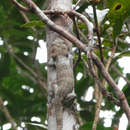ar
الأسماء في صفحات التنقل


Characteristics of Gehyra membranacruralis include its broadened toe pads and coarse granular scales. The pattern of scales on its back resembles a six-pointed star. Each large scale is surrounded by six small scales. Because it is nocturnal, Gehyra membranacruralis has pupils which narrow to vertical slits in bright light, but expand in the dark.
The head is of moderate size and is slightly depressed. All digits are clawed, the fifth digit with a minute claw. Digits all "strongly dilated with an undivivded series of 11-18 lamellae under the median toes" (McCoy, 1980). The hindlimbs of Gehyra membranacruralis have a distinct fold along their posterior edges. Its color is light or dark brown with irregular lighter and darker flecking over the dorsum, limbs, and tail. The venter of Gehyra membranacruralis is cream to yellow, with bright yellow or orange on the underside of its tail (McCoy, 1980). If grasped, Gehyra membranacruralis will shed pieces of its skin.
Gehyra membranacruralis was recently described, originally being referred to the species Gehyra oceania (Beckon, 1992).
Conservation of this gecko is dependent upon the survival of its natural habitat. In past years it was hunted for food on smaller islands, but on larger islands a more profitable species was found (Beckon 1992).
US Federal List: no special status
CITES: no special status
At one time, Gehyra membranacruralis was considered a source of food for people living on the smaller islands of the south Pacific Ocean.
Gehyra membranacruralis is a carnivore that eats insects, spiders, and smaller geckos (McCoy 1980).
Gehyra membranacruralis can be found on certain islands of the south Pacific Ocean. These islands include but are not limited to, Fiji, New Guinea, Tonga, and Vanuatu (Beckon,1999).
Biogeographic Regions: oriental (Native ); australian (Native )
Gehra vorax is found in tropical climates. It can sometimes be found in human habitations, especially buildings with suitable hiding places. These spaces are abundant in plaited bamboo, reed walls, or thatched roofs (Beckon,1999). Gehyra membranacruralis can be found on larger trees, basking in the sun on the trunk, during the day. It relies on its cryptic coloring for protecion from its predators. It can also be found on the "crowns of coconuts and sago palms" (McCoy, 1980). Gehyra membranacruralis have also been known to inhabit mangrove forests, woodland grasslands, and lowland forests (Alcala, 1986).
Terrestrial Biomes: savanna or grassland ; scrub forest
Like some other members of the family Gekkonidae, Gehyra membranacruralis uses vocalizations when trying to find a mate or marking its territory. This species is oviparous, laying two eggs at a time. Gehyra membranacruralis lays its eggs under loose bark, in tree hollows, or in the ceilings of houses (McCoy, 1980).
Gehyra vorax, also known as the voracious four-clawed gecko or voracious dtella, is a gecko native to Papua New Guinea, Fiji, and Tonga.[1]
Gehyra vorax, also known as the voracious four-clawed gecko or voracious dtella, is a gecko native to Papua New Guinea, Fiji, and Tonga.
El Gehyra vorax es una especie de gecko oriundo de Fiyi, Vanuatu y Nueva Guinea.[1]
De clima tropical habita en bosques de manglares, pastizales, bosques y bosques de tierras bajas.
Se lo puede encontrar asoleándose, confiado en su mimetismo, en el tronco de un árbol o sobre la copa de palmeras.[2] También suele esconderse en recovecos en las viviendas.
Es de color marrón claro u oscuro, con manchas irregulares claras y más oscuras en el dorso, las extremidades y la cola. El vientre de Gehyra vorax es color crema a amarillo, con color amarillo brillante o naranja en la parte inferior de la cola.[2] Es un animal nocturno y su dieta incluye insectos y hasta geckos más pequeños.[2] Al igual que algunos otros miembros de la familia Gekkonidae, el Gehyra vorax utiliza vocalizaciones cuando se trata de encontrar a un compañero o marcar su territorio. Es ovíparo poniendo dos huevos a la vez los cuales deja debajo de corteza, huecos en árboles o en el techo de las casas (de paja)[2]
Usualmente es confundido con el gecko marginado (Gehyra marginata) pero, mientras este tiene ojos color verdes, el G. vorax los tiene marrones.
Gehyra vorax se distribuye naturalmente en ciertas islas del sur del Océano Pacífico. Estas islas incluyen, entre otras, Fiji, Nueva Guinea, Tonga y Vanuatu. También, ha sido registrada e introducida en la república argentina. [3]
El Gehyra vorax es una especie de gecko oriundo de Fiyi, Vanuatu y Nueva Guinea.
De clima tropical habita en bosques de manglares, pastizales, bosques y bosques de tierras bajas.
Se lo puede encontrar asoleándose, confiado en su mimetismo, en el tronco de un árbol o sobre la copa de palmeras. También suele esconderse en recovecos en las viviendas.
Gehyra vorax Gehyra generoko animalia da. Narrastien barruko Gekkonidae familian sailkatuta dago.
Gehyra vorax Gehyra generoko animalia da. Narrastien barruko Gekkonidae familian sailkatuta dago.
Gehyra vorax est une espèce de geckos de la famille des Gekkonidae[1].
Cette espèce se rencontre en Nouvelle-Guinée occidentale, en Papouasie-Nouvelle-Guinée, aux Fidji, aux Tonga et dans les îles de la Société[1].
Sa présence en Nouvelle-Calédonie est incertaine.
Ce gecko a un aspect très massif. La couleur de base est un brun sombre avec des irrégularités de couleurs. La peau a également un aspect irrégulier. Le dessous du corps est blanc-beige. Les pattes sont très épaisses, avec des griffes longues et des doigts très larges.
Gehyra vorax est une espèce de geckos de la famille des Gekkonidae.
Gehyra vorax là một loài thằn lằn trong họ Gekkonidae. Loài này được Girard mô tả khoa học đầu tiên năm 1858.[1]
Gehyra vorax là một loài thằn lằn trong họ Gekkonidae. Loài này được Girard mô tả khoa học đầu tiên năm 1858.